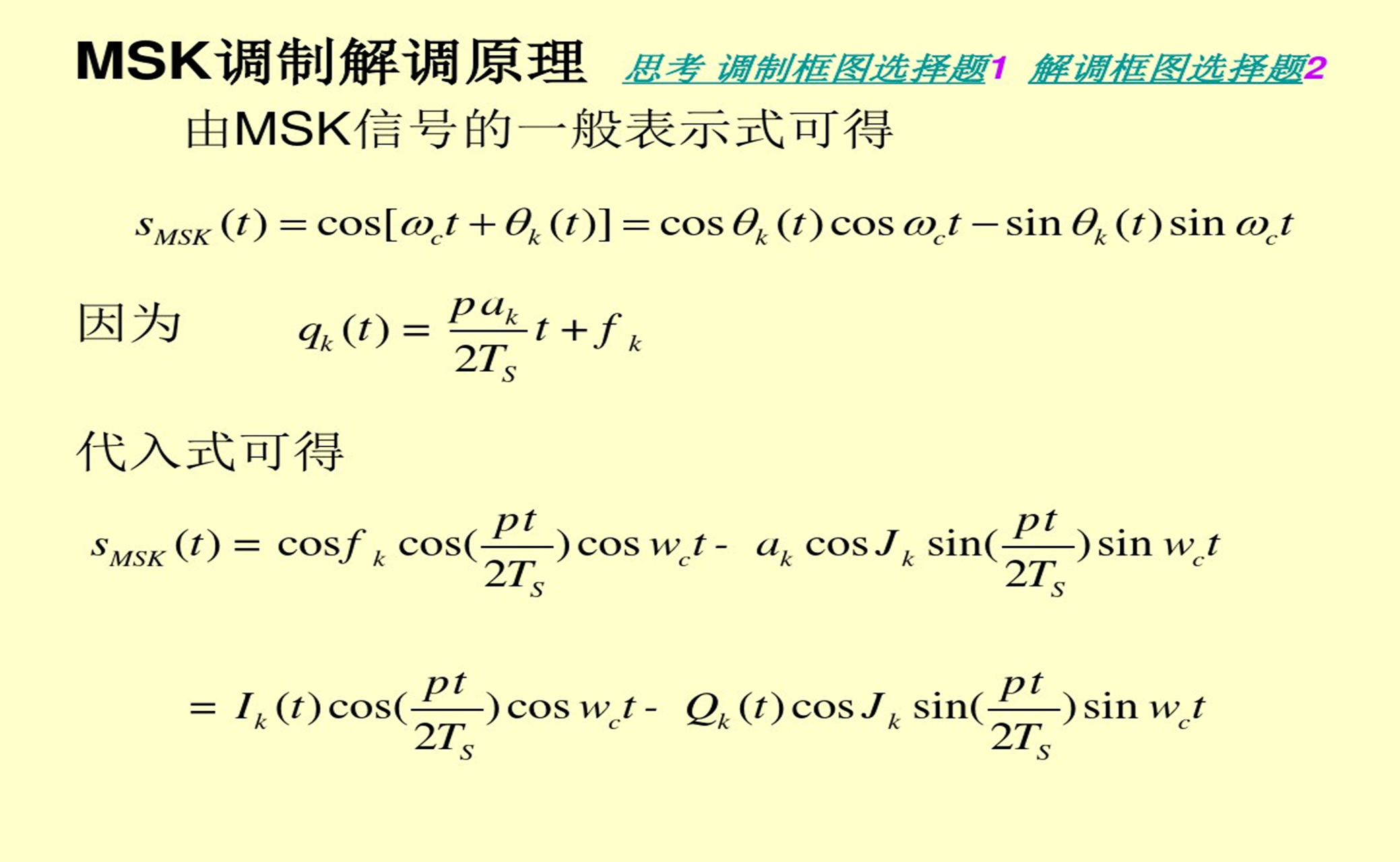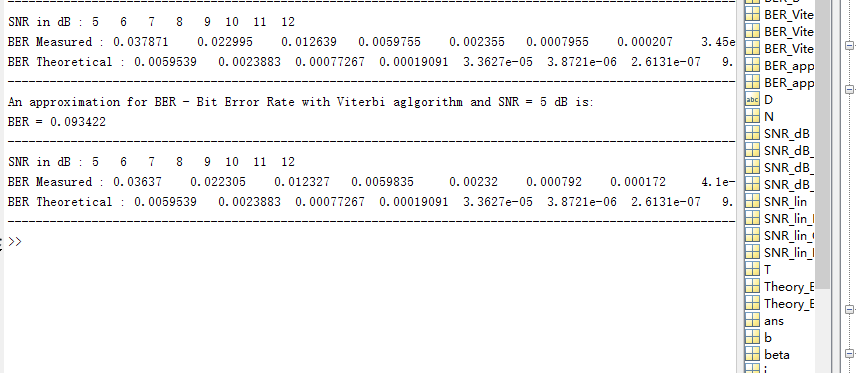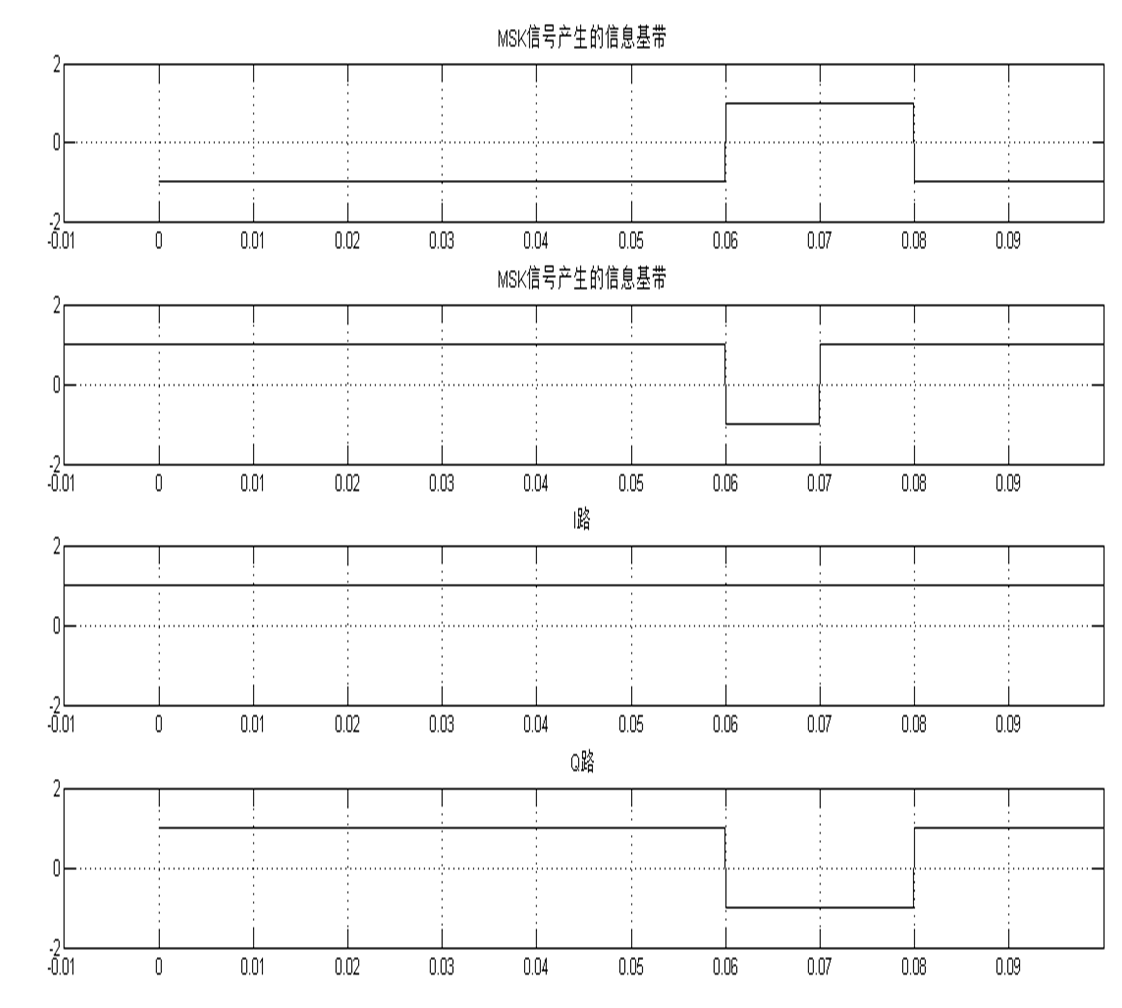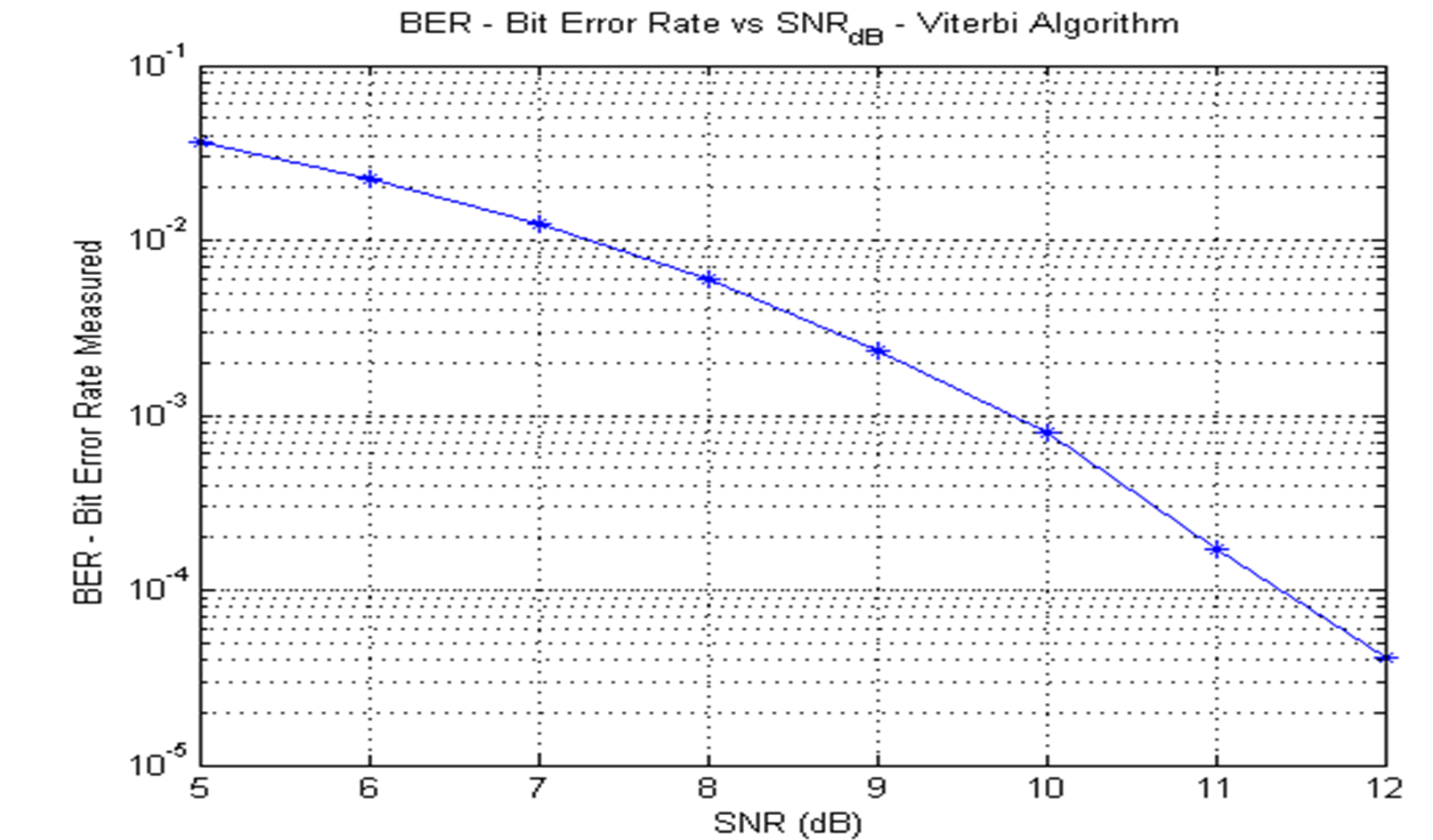前言
一个实现数字通信下msk调制与解调的MATLAB仿真,以及利用维特比算法实现维特比解码。通过维特比解码来实现最大似然解码的一些个人见解,最后得出信噪比与误码率之间的图像。
一、MSK是什么?


在这里插入图片描述






二、仿真代码
clear all
close all
clc
%-------------------------------------------------------------------------%
% PART 1.1 %
%-------------------------------------------------------------------------%
N = 1e4; % 10^5
A = 1;
T = 0.01;
% 生成一个符号序列{-1,1}
b = (sign(randn(1,2*N))+1)/2;
for i=1:1:length(b)
if b(i)==0
b(i)=-1;
end
end
% 应用递归方程对QPSK中的符号进行变换
% symbols
xQ_1 = -1;
x_1 = 1;
xI_n = zeros(1,N);
xQ_n = zeros(1,N);
for n=1:1:N
if n==1
xI_n(n) = -xQ_1*x_1;
xQ_n(n) = -xI_n(n)*b(n);
elseif n~=1
xI_n(n) = -xQ_n(n-1)*b(2*(n-1));
xQ_n(n) = -xI_n(n)*b(2*n-1);
end
end
xI_n; % 同相分量
xQ_n; % 正交分量
z_n = xI_n + 1i*xQ_n; % Add in - phase and quadrature component to create z_n
% 计算误码率
iter = 1e2;
SNR_dB = 5;
SNR_lin = 10.^(SNR_dB/10); % 10log_10(SNR_lin)
BER_appr = 0;
for p=1:1:iter
n = randn(1,N) + 1i*randn(1,N);
y_n = A*T*z_n + sqrt(A^2*T^2/SNR_lin)*n;
y_Re = sign(real(y_n)); % 当出现负数时返回-1,否则返回1
y_Im = sign(imag(y_n));
BER_appr = BER_appr + sum(y_Im ~= imag(z_n)) + sum(y_Re ~= real(z_n));
end
BER = BER_appr/(N*iter);
D = ['BER = ', num2str(BER)];
disp('------------------------------------------------------------------------------------------------------------------------------------');
disp('An approximation for BER - Bit Error Rate with SNR = 5 dB is:');
disp(D);
disp('------------------------------------------------------------------------------------------------------------------------------------');
SNR_dB_B = 5:12; % Values of SNR in dB
SNR_lin_B = 10.^([5:12]/10); % Values of SNR in decimal
BER_B = zeros(1,length(SNR_lin_B));
BER_appr_B = zeros(1,length(SNR_lin_B));
for k=1:1:length(SNR_lin_B)
for p=1:1:iter
n = randn(1,N) + 1i*randn(1,N);
y_n = A*T*z_n + sqrt(A^2*T^2/SNR_lin_B(k))*n;
y_Re = sign(real(y_n)); % returns -1 when a negative number occur and 1 otherwise
y_Im = sign(imag(y_n));
BER_appr_B(k) = BER_appr_B(k) + sum(y_Im ~= imag(z_n)) + sum(y_Re ~= real(z_n));
end
BER_B(k) = BER_appr_B(k)/(2*N*iter);
Theory_BER(k) = 0.5*erfc(sqrt(SNR_lin_B(k))); % theoretical BER
end
disp(['SNR in dB : ' num2str(SNR_dB_B)]);
disp(['BER Measured : ' num2str(BER_B)]);
disp(['BER Theoretical : ' num2str(Theory_BER)]);
disp('------------------------------------------------------------------------------------------------------------------------------------');
figure(1)
semilogy(SNR_dB_B,BER_B,'b-*')
xlabel('SNR (dB)')
ylabel('BER - Bit Error Rate Measured')
title('BER - Bit Error Rate vs SNR_{dB}')
grid on
figure(2)
semilogy(SNR_dB_B,BER_B,'b-*')
hold on
semilogy(SNR_dB_B,Theory_BER,'m-o')
xlabel('SNR (dB)')
ylabel('BER - Bit Error Rate Measured & Theoretical')
title('BER - Bit Error Rate vs SNR_{dB}')
legend('BER - Measured', 'BER - Theoretical')
grid on
%-------------------------------------------------------------------------%
% PART 1.2 %
%-------------------------------------------------------------------------%
SNR_dB_C = 5;
SNR_lin_C = 10.^(SNR_dB_C/10);
% Creating the symbols x(n) in set {-1,1}
b = (sign(randn(1,N))+1)/2;
for i=1:1:length(b)
if b(i)==0
b(i)=-1;
end
end
% Constructing the vectors s_1 & s1
% s_1 is for s^(-1)
% s1 is for s^1
s_1 = [-(2*A*sqrt(T)*1i)/pi; (A*sqrt(T)*sqrt(pi^2 - 4))/pi];
s1 = [A*sqrt(T); 0];
beta = (A^2*T)/SNR_lin_C; % From equation (16)
var = 2*beta;
BER_Viterbi = 0; %initialising BER
for p=1:1:iter
n1_n = sqrt(var)*(randn(1,N) + 1j*randn(1,N)); % Generating the values of the noise vector n1_n
n2_n = sqrt(var)*(randn(1,N) + 1j*randn(1,N));
phase(1) = 0;
for n=1:1:N
phase(n+1) = phase(n) + b(n)*pi/2;
if b(n) == -1
r_n(:,n) = s_1.*exp(1i*phase(n)) + [n1_n(n); n2_n(n)]; % if x(n) == -1
elseif b(n) == 1
r_n(:,n) = s1.*exp(1i*phase(n)) + [n1_n(n); n2_n(n)]; % if x(n) == 1
end
end
x_opt = Viterbi(N,s1,s_1,r_n);
BER_Viterbi = BER_Viterbi + sum(b~=x_opt);
end
BER_Viterbi = BER_Viterbi/(2*N*iter);
disp('An approximation for BER - Bit Error Rate with Viterbi aglgorithm and SNR = 5 dB is:');
disp(['BER = ', num2str(BER_Viterbi)])
% disp(['BER Theoretical : ' num2str(Theory_BER)]);
disp('------------------------------------------------------------------------------------------------------------------------------------');
% Creating the BER diagram for SNR = 5,6,7,8,9,10,11,12
SNR_dB_E = 5:12;
SNR_lin_E = 10.^(SNR_dB_E/10);
BER_Viterbi_E = zeros(1,length(SNR_lin_E));
BER_Viterbi_appr_E = zeros(1,length(SNR_lin_E));
% Constructing the vectors s_1 & s1
s_1 = [-(2*A*sqrt(T)*1i)/pi; (A*sqrt(T)*sqrt(pi^2 - 4))/pi];
s1 = [A*sqrt(T); 0];
for k=1:1:length(SNR_lin_E)
for p=1:1:iter
n1_n = sqrt(A^2*T/SNR_lin_E(k))*(randn(1,N) + 1j*randn(1,N)); % Generating the values of the noise vector n1_n
n2_n = sqrt(A^2*T/SNR_lin_E(k))*(randn(1,N) + 1j*randn(1,N));
phase(1) = 0;
for n=1:1:N
phase(n+1) = phase(n) + b(n)*pi/2;
if b(n) == -1
r_n(:,n) = s_1.*exp(1i*phase(n)) + [n1_n(n); n2_n(n)]; % if x(n) == -1
elseif b(n) == 1
r_n(:,n) = s1.*exp(1i*phase(n)) + [n1_n(n); n2_n(n)]; % if x(n) == 1
end
end
x_opt = Viterbi(N,s1,s_1,r_n);
BER_Viterbi_appr_E(k) = BER_Viterbi_appr_E(k) + sum(b~=x_opt);
Theory_BER_Viterbi(k) = 0.5*erfc(sqrt(SNR_lin_E(k))); % theoretical BER
end
BER_Viterbi_E(k) = BER_Viterbi_appr_E(k)/(2*N*iter);
end
disp(['SNR in dB : ' num2str(SNR_dB_E)]);
disp(['BER Measured : ' num2str(BER_Viterbi_E)]);
disp(['BER Theoretical : ' num2str(Theory_BER_Viterbi)]);
disp('------------------------------------------------------------------------------------------------------------------------------------');
figure(3)
semilogy(SNR_dB_E,BER_Viterbi_E,'b-*')
xlabel('SNR (dB)')
ylabel('BER - Bit Error Rate Measured ')
title('BER - Bit Error Rate vs SNR_{dB} - Viterbi Algorithm')
grid on
figure(4)
semilogy(SNR_dB_E,BER_Viterbi_E,'b-*'),
hold on
semilogy(SNR_dB_B,BER_B,'g-*'),
hold on
semilogy(SNR_dB_B,Theory_BER,'m-o')
xlabel('SNR (dB)')
ylabel('BER - Bit Error Rate Measured & Theoretical')
title('BER - Bit Error Rate vs SNR_{dB}')
legend('BER - Viterbi','BER - Measured', 'BER - Theoretical','Location','southwest')
grid on
2.维特比算法代码
function [x_opt] = Viterbi(N, s1, s_1, r_n)
%-------------------------------------------------------------------------%
% FORWARD %
%-------------------------------------------------------------------------%
pointer_pi(1) = -1;
pointer_0(1) = -1;
for n=1:1:N
if n==1
w_3pi2(n) = real(r_n(:,n)'*s_1*exp(1i*0)); % 第一步
w_pi2(n) = real(r_n(:,n)'*s1*exp(1i*0));
elseif n~=1
if mod(n,2)==0 % Even bits
% Even symbols can end up ONLY with phase pi or 0
% From 3pi/2 to pi with symbol -1
% From 3pi/2 to 0 with symbol +1
w3pi2_pi(n) = real(r_n(:,n)'*s_1*exp(1i*3*pi/2));
w3pi2_0(n) = real(r_n(:,n)'*s1*exp(1i*3*pi/2));
% From pi/2 to pi with symbol +1
% From pi/2 to 0 with symbol -1
wpi2_pi(n) = real(r_n(:,n)'*s1*exp(1i*pi/2));
wpi2_0(n) = real(r_n(:,n)'*s_1*exp(1i*pi/2));
% The cost may be the weight(3pi/2, pi) + the weight of the
% last symbol 3pi/2 due to the memory property of the phase.
% The cost may be the weight(pi/2, pi) + the weight of the
% last symbol pi/2 due to the memory property of the phase.
total_cost_1 = w3pi2_pi(n) + w_3pi2(n-1);
total_cost_2 = wpi2_pi(n) + w_pi2(n-1);
[w_pi(n),pointer_pi(n)] = max([total_cost_1 0 total_cost_2 0]);
% The cost may be the weight(3pi/2, 0) + the weight of the
% last symbol 0 due to the memory property of the phase.
% The cost may be the weight(pi/2, 0) + the weight of the
% last symbol 0 due to the memory property of the phase.
total_cost_1 = w3pi2_0(n) + w_3pi2(n-1);
total_cost_2 = wpi2_0(n) + w_pi2(n-1);
[w_0(n),pointer_0(n)] = max([total_cost_1 0 total_cost_2 0]);
elseif mod(n,2)~=0 % Odd bits
% Odd symbols can end up ONLY with phase 3pi/2 or pi/2
% From 0 to 3pi/2 with symbol -1
% From 0 to pi/2 with symbol +1
w0_3pi2(n) = real(r_n(:,n)'*s_1);
w0_pi2(n) = real(r_n(:,n)'*s1);
% From pi to 3pi/2 with symbol +1
% From pi to pi/2 with symbol -1
wpi_3pi2(n) = real(r_n(:,n)'*s1*exp(1j*pi));
wpi_pi2(n) = real(r_n(:,n)'*s_1*exp(1j*pi));
% The cost may be the weight(pi, 3pi/2) + the weight of the
% last symbol pi due to the memory property of the phase.
% The cost may be the weight(0, 3pi/2) + the weight of the
% last symbol 0 due to the memory property of the phase.
total_cost_1 = wpi_3pi2(n) + w_pi(n-1);
total_cost_2 = w0_3pi2(n) + w_0(n-1);
[w_3pi2(n),pointer_3pi2(n)] = max([0 total_cost_1 0 total_cost_2]);
% The cost may be the weight(pi, pi/2) + the weight of the
% last symbol pi due to the memory property of the phase.
% The cost may be the weight(0, pi/2) + the weight of the
% last symbol 0 due to the memory property of the phase.
total_cost_1 = wpi_pi2(n) + w_pi(n-1);
total_cost_2 = w0_pi2(n) + w_0(n-1);
[w_pi2(n),pointer_pi2(n)] = max([0 total_cost_1 0 total_cost_2]);
end
end
end
%-------------------------------------------------------------------------%
% BACKWARD %
%-------------------------------------------------------------------------%
% 只保留给出最大权重和的路径
if mod(n,2)~=0
[~,route(N+1)] = max([w_3pi2(n) 0 w_pi2(n) 0]);
elseif mod(n,2)==0
[~,route(N+1)] = max([0 w_pi(n) 0 w_0(n)]);
end
route(1) = 4;
for n=N:-1:1
if n~=1
if mod(n,2)==0 % Even symbols
[~,p] = max([0 w_pi(n) 0 w_0(n)]);
enter = [0 pointer_pi(n) 0 pointer_0(n)];
route(n) = enter(p);
elseif mod(n,2)~=0 % Odd symbols
[~,p] = max([w_3pi2(n) 0 w_pi2(n) 0]);
enter = [pointer_3pi2(n) 0 pointer_pi2(n) 0];
route(n) = enter(p);
end
end
route;
% Restoring the symbols
if route(n)-route(n+1)==-1
x_opt(n) = -1;
elseif route(n)-route(n+1)==1
x_opt(n) = 1;
elseif route(n)-route(n+1)==-3
x_opt(n) = 1;
elseif route(n)-route(n+1)==3
x_opt(n) = -1;
end
end
end

图像




信噪比与误码率的函数图像:







最后
以上就是俊秀金毛最近收集整理的关于数字通信——MSK调制解调,维特比解码下误码率与信噪比之间的关系前言一、MSK是什么?二、仿真代码图像的全部内容,更多相关数字通信——MSK调制解调,维特比解码下误码率与信噪比之间内容请搜索靠谱客的其他文章。
本图文内容来源于网友提供,作为学习参考使用,或来自网络收集整理,版权属于原作者所有。








发表评论 取消回复